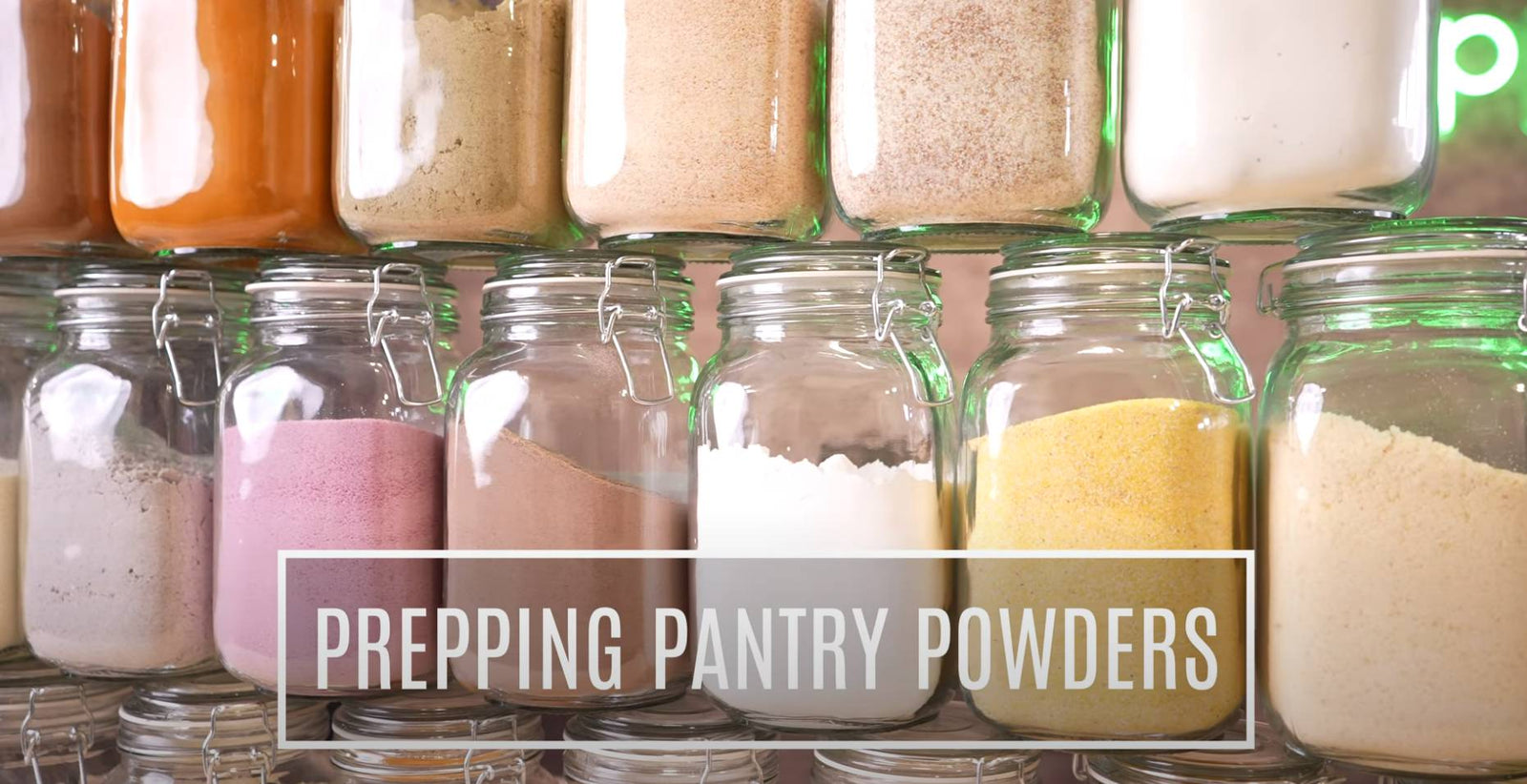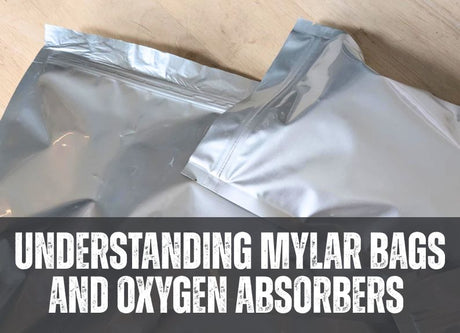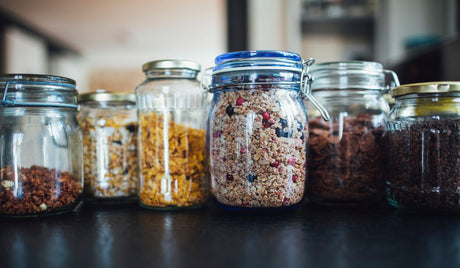Powdered food is the most efficient way to store food as they pack the most nutrients and calories into the most compact volume. In addition, when stored properly, powdered foods can last for a very long time. This checklist will go over 25 powdered foods you should be stockpiling and why. Many powdered foods are made by first freeze-drying produce and then using a food processor to turn it into a powder. You can prep your foods at home or stock up on commercially available products at your local bulk food grocery store. To learn how to prepare your food for long-term storage, read our blog on dehydrating and powder foods.

-
Eggs
Eggs are an incredible addition to your diet. They are a necessity in many foods we enjoy, and they contain essential vitamins and minerals. In addition, eggs are one of the easiest sources of nutrition, carbohydrates, and essential fat for your body to digest. Eggs are an indispensable source of micro and macronutrients, making them a pantry staple for stockpiling.
-
Peanut butter
Peanut butter is tricky to freeze dry at home due to its high fat content, but peanut butter powder is worth buying and storing. Peanut butter powder is an incredible source of protein and fibre. When purchasing, it is vital to ensure that the fat content of the powder is low, as the higher it is, the faster it will spoil. Peanut butter powder can be used in much the same way you use peanut butter in recipes.
-
Milk
Powdered milk is very accessible and highly valuable! It is an excellent source of nutrition as well as being incredibly versatile. Add to any recipe, soup, or on its own.
-
Hemp seed

Hemp seeds are a fantastic superfood. They are incredibly high in protein, making them a valuable addition to any meal. Like peanut butter, choose a powder with the lowest possible fat content for long shelf life.
-
Baking powder
Excellent for cooking due to its leavening qualities. In addition, because it contains sodium bicarbonate, it can be used well after it is no longer suitable for cooking. Also, a useful ingredient to have for bartering and trading.
-
Cocoa
While it has become fairly ubiquitous, cocoa is quite rare for those living in North America if you can’t go to the grocery store. Not only can it help to make tasty chocolate, but it is rich in polyphenols (especially flavonol), which have been shown to reduce inflammation, increase blood flow, lower blood pressure, and improve cholesterol and blood sugar levels. When purchasing, be conscientious about buying a high-quality powder that hasn’t been overly heat-treated, which reduces the naturally occurring antioxidant properties.
-
Spices

Cinnamon does more than make food taste delicious; it is also a great source of antioxidants and boasts anti-fungal properties. You can add cinnamon to other foods to increase their shelf life. Ginger can reduce nausea, and garlic is a powerful immune system booster. Several spices are incredibly easy to freeze dry, which can benefit you and your family and have a long shelf life. Choosing the best quality spices, especially fresh ones you grew in your garden, is best for freeze-drying, but buying bulk spices is both cost-effective and best for harder-to-access spices like turmeric or fenugreek. Spices are overlooked but can be significant additions to your food stores for both health and flavour.
-
Whey
Whey is a byproduct of cheese production, and while the shelf life is shorter than other types of protein-rich powders, with proper storage, it will likely last much longer than the expiration date would suggest.
-
Cheese
Cheese powder can be made from freeze-dried cheddar or parmesan, or you can simply stockpile kraft dinner powder. It’s nutritious and will help make food more palatable––especially if you have young children. While the kraft powder might be the least ideal form of powdered cheese, it is also easily accessible, making it easy to stockpile.
-
Pancake powder
While this is a combination of other ingredients listed here, you can make your own or buy it pre-made. It is valuable to have it stored ready to make, especially if you need carbs quickly and easily. In addition, its shelf life is pretty much indefinite if stored correctly.
-
Alfredo powder
You can create gourmet meals by having pre-made powdered sauce mixtures stocked and ready. Alfredo powder is a great way to make many different foods taste good, especially if you have little kids to worry about in a disaster.
-
Potatoes
Whether you stock flakes or powdered potatoes, they are an excellent powerhouse vegetable to have in your dried food arsenal. While it can stand alone as a carb-filled meal, you can also add it to a wide variety of recipes, as well as use it as a thickening agent or flour.
-
Chickpeas/garbanzo beans

Like all legumes, this will store for a long time and is an incredibly nutrient-rich food to have in your storeroom. Not only does combining beans and rice create a whole protein if you’re a vegetarian, but chickpeas are also rich in amino acids and other micronutrients.
-
Soup stock
With a long shelf life and chock full of energy and protein, a good supply of soup stock is never bad to stockpile. Because it is highly prone to moisture, repackaging it in mylar with an oxygen absorbing packet is highly recommended.
-
Powdered gravy
Not only delicious but can be used on everything from reconstituted freeze-dried meats to potato flakes. Good to have on hand, especially for picky eaters.
-
Cornmeal
It's great in cakes and bread and is the key ingredient in foods like polenta. In addition to tasting delicious, it has a long shelf life, and whole-grain cornmeal is an excellent source of fibre and other nutrients.
-
Jello
While Jello doesn’t have any real nutritional benefit, unless you get true gelatin which contains collagen, it is a great morale booster if you have young children. When times are hard, a little goes a long way.
-
Cream of wheat
This is a filling meal made of wheat semolina. It is similar to grits, which are made from cornmeal, but with a soft creamy texture––especially when combined with milk. It’s a great breakfast food and can be customized with sugar, cinnamon, or dried fruits. It is a great source of nutrients, including niacin, vitamin B6, thiamine, riboflavin, and folate. It's also rich in iron, which is especially good for vegetarians and vegans.
-
Juice crystals
Whichever juice crystals you choose, they are great to have on hand. In an emergency, water is often hard to come by, and it may be difficult for you or your family to get used to the taste of water from places other than the tap or water that has been sterilized with bleach or iodine. Juice crystals can help to ensure everyone gets enough fluids.
-
Cornstarch
Cornstarch is made from the endosperm of corn kernels. It is handy as a thickening agent in foods like soup, gravies, and sauces. This will be good to have if you plan on making your own powdered gravy or soup bases. Many people also use cornstarch in natural deodorants, as dry shampoo, and for skin relief.
-
Meat
Powdered meats can be used to create soups or as an additional source of protein when cooking rice, vegetables, and more. Once meat is freeze-dried, it can be stored safely without refrigeration, so it’s a great addition to your stock.
-
Fruit
You can use fruit powders in smoothies, to flavour water, or in hot cereal. It’s a great alternative to storing whole fruits, which are a bit bulkier.
-
Tea and coffee
Instant coffee is not only a great bartering item, but caffeine is a luxury that is rapidly depleting. Tea can be stored almost indefinitely and can provide that caffeine kick. Many types of tea, such as peppermint, labrador, and raspberry leaf, have numerous applications in natural medicine.
-
Honey

Powdered honey may not be something you think of right away, but it can make the sticky jar version a lot easier to take in a backpack. Honey has a host of antibacterial properties, health benefits, and more.
-
Yogurt
There are numerous benefits, like protein and calcium, that make it worth powdering. Probiotics are also preserved in the flash-freezing process, so your guts will thank you for stocking it. In addition to nutrition, yogurt is also a delicious alternative in dips, soups, and sauces.
It is critical to store food properly when preparing for emergencies.

The best way to store your powdered or dehydrated foods is with vacuum-sealed mylar bags with silica gel packs and an oxygen absorber. The silica gel will ensure that no moisture can spoil your foods, and the oxygen absorber will ensure that oxygen doesn’t oxidize your hard-earned spoils. In addition to mylar bags, you can store multiple bags in large plastic containers to eliminate pest damage and make storage easier by stacking containers. Preventing spoilage is the primary concern when thinking about long-term food storage, so it is critical to do it properly. The last thing you want in an emergency is to discover that your food supply has been compromised in any way.
Powdered food is essential in your emergency preparedness plan.
With proper storage, powdered foods will last a very long time, making them an invaluable addition to your emergency food stores. In addition to more obvious things like flour, sugar, and salt, we hope you could get an idea of the range of foods that you can stockpile now.
Want to learn more? Visit our Youtube page.
We have several videos that cover emergency food preparation and storage.










